
iStockphoto
A newly study published on Monday by astronomers from the University of Melbourne and Monash University reveals the finding of what is known as a “Goldilocks” black hole that is 55,000 times bigger than the sun.
Considering the fact that the sun is about 330,000 times the size of Earth and around 1.3 million Earths could fit inside the sun, this “Goldilocks” black hole is a big one.
The study, published in the journal Nature Astronomy, shares evidence that it is one of the oldest black holes in the universe.
This intermediate mass “Goldilocks” black hole (between 100 to 100,000 times the mass of the sun) is also just the second of its kind ever to be discovered. The first was discovered just last year.
Scientists hope to use this new discovery to both how it connects two different types of black holes – those made from collapsing stars and supermassive black holes at the center of most galaxies – as well as how black holes are created.
“While we know that these supermassive black holes lurk in the cores of most, if not all galaxies, we don’t understand how these behemoths are able to grow so large within the age of the Universe,” said lead author James Paynter of the University of Melbourne.
Study co-author Eric Thrane of Monash University added, “This newly discovered black hole could be an ancient relic — a primordial black hole — created in the early Universe before the first stars and galaxies formed.”
The new black hole was found through the detection of a gravitationally lensed gamma-ray burst. The gamma-ray burst, a half-second flash of high-energy light emitted by a pair of merging stars, was observed to have a tell-tale ‘echo’. This echo is caused by the intervening intermediate-mass black hole, which bends the path of the light on its way to Earth, so that astronomers see the same flash twice.
Powerful software developed to detect black holes from gravitational waves was adapted to establish that the two flashes are images of the same object.
“These early black holes may be the seeds of the supermassive black holes that live in the hearts of galaxies today,” said study co-author and University of Melbourne professor Rachel Webster.
“Using this new black hole candidate, we can estimate the total number of these objects in the Universe. We predicted that this might be possible 30 years ago, and it is exciting to have discovered a strong example.”